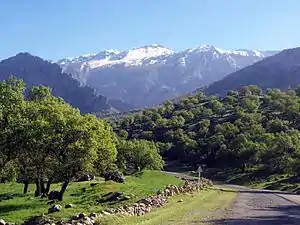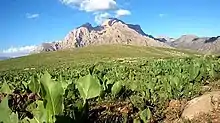Zagros Mountains forest steppe
The Zagros Mountains forest steppe is a temperate broadleaf and mixed forests ecoregion in western Asia. The ecoregion extends along the Zagros Mountains, stretching from eastern Turkey and northern Iraq to southern Iran.
| Zagros Mountains forest steppe | |
|---|---|
 Landscape near Shadegan | |
 Map of the ecoregion | |
| Ecology | |
| Realm | Palearctic |
| Biome | temperate broadleaf and mixed forests |
| Borders | |
| Geography | |
| Area | 397,555 km2 (153,497 sq mi) |
| Countries | Iran, Iraq, and Turkey |
| Conservation | |
| Conservation status | Critical/endangered[1] |
| Protected | 20,339 km² (5%)[2] |
Geography
The Zagros Mountains are a belt of folded mountains formed by the collision of the African Plate with the Eurasian Plate. On the west, south, and east, the mountains are surrounded by deserts and semi-deserts. The dry grasslands, shrublands, and low-lying deserts of Mesopotamia and southern Iran lie to the west, and the plateau deserts of the Iranian Plateau to the east. The Armenian Highlands and Alborz Mountains lie to the north.
Climate
The ecoregion's climate is semi-arid and temperate. Annual precipitation ranges from 400 m to 800 mm, and falls mostly in winter and spring. Summers are hot and dry, and winters are cold, with the coldest winter temperatures dropping below -25º C. Temperatures are generally warmer and the climate drier at the southern end of the range.
Flora
.JPG.webp)
The predominant plant community in the mountains is forest or open woodland of deciduous broadleaf trees, with an understory of of steppe shrubs and grasses. Oaks, particularly Persian oak (Quercus brantii), are the characteristic trees, covering over 50% of the Zagros mountains in Iran.[3] Pistachio (Pistacia spp.) forms groves, and grows in association with oaks. Vegetation varies with altitude and exposure to prevailing winds. In the northern part of the ecoregion, shrub steppe of Astragalus spp. and Salvia spp. with scattered trees occurs above 400m to 500m elevation. Forests and forest remnants of Quercus brantii and/or Q. boissieri occur from 700 to 800 meters elevation to about 1,700 m. The treeline is at 1,900 to 2,000 meters elevation, with sub-alpine vegetation above it.[1]
At the southern end of the range, the trees are sparser and more open, and the steppe vegetation is more prominent. Steppe extends up to 1400 meters elevation, and open woodlands of Quercus brantii, hawthorn (Crataegus), almond (Prunus amygdalus), nettle tree (Celtis spp.) and pear (Pyrus syriaca and Pyrus glabra) continue up to 2,400 meters.[1]
Although degraded from overgrazing and deforestation, the Zagros is home to a rich and complex flora. Remnants of the originally widespread oak-dominated woodland can still be found, as can park-like pistachio-almond steppelands. The wild ancestors of many important food plants, including wheat, barley, lentil, almond, walnut, pistachio, apricot, plum, pomegranate, and grape, grow throughout the mountains.[4]

Endemic plants of the mountain range include Allium iranicum, Astragalus crenophila, Bellevalia kurdistanica, Cousinia carduchorum, Cousinia odontolepis, Echinops rectangularis, Erysimum boissieri, Iris barnumiae, Ornithogalum iraqense, Scrophularia atroglandulosa, Scorzonera kurdistanica, Tragopogon rechingeri, and Tulipa kurdica.[5]
Fauna
The Zagros are home to many threatened and endangered animals, including the Persian leopard (Panthera pardus tulliana), Syrian brown bear (Ursus arctos syriacus), mouflon (Ovis orientalis orientalis), wolf (Canis lupus), striped hyena (Hyena hyena), Blanford's fox (Vulpes cana), and Zagros Mountains mouse-like hamster (Calomyscus bailwardi). Wild goats (Capra aegrarus) can be found throughout the Zagros Mountains. The Persian fallow deer (Dama dama mesopotamica), an ancient domesticate once thought extinct, was rediscovered in the late 20th century in Khuzestan Province in the southern Zagros.[1]
In the late 19th century, the Asiatic lion (Panthera leo persica) inhabited the southwestern part of the mountains.[6] It is now extinct in this region.[7]
The Luristan newt (Neurergus kaiseri) is a vulnerable species endemic to the central Zagros mountains of Iran.
Protected areas
A 2017 assessment found that 20,339 km², or 5%, of the ecoregion is in protected areas.[2] Protected areas include:[8]
- Arjan and Parishan Protected Area (IUCN category V, 597.8 km²)
- Bamou National Park (IUCN category II, 486.8 km²)
- Bakhtegan Wildlife Refuge (IUCN category IV, 2004 km²)
- Kolahghazi Wildlife Refuge (IUCN category IV, 41.2 km²)
- Dez Wildlife Refuge (IUCN category IV, 53 km²)
- Bijar Protected Area (IUCN category V, 316.1 km²)
- Bahramgor Protected Area (IUCN category V, 4080 km²)
- Angoran Protected Area (IUCN category V, 923.2 km²)
- Dez Protected Area (IUCN category V, 175.3 km²)
- Karkheh Protected Area (IUCN category V, 140 km²)
External link
- "Zagros Mountains forest steppe". Terrestrial Ecoregions. World Wildlife Fund.
References
- "Zagros Mountains forest steppe". Terrestrial Ecoregions. World Wildlife Fund.
- Dinerstein, Eric; Olson, David; et al. (June 2017). "An Ecoregion-Based Approach to Protecting Half the Terrestrial Realm". BioScience. 67 (6): 534–545. doi:10.1093/biosci/bix014. PMC 5451287. PMID 28608869.CS1 maint: date and year (link) Supplemental material 2 table S1b.
- M. Heydari; H. Poorbabaei; T. Rostami; M. Begim Faghir; A. Salehi; R. Ostad Hashmei (2013). "Plant species in Oak (Quercus brantii Lindl.) understory and their relationship with physical and chemical propertiesof soil in different altitude classes in the Arghvan valley protected area, Iran" (PDF). Caspian Journal of Environmental Sciences, 2013, Vol. 11 No.1, pp. 97~110. Archived from the original (PDF) on 3 April 2015. Retrieved 10 April 2014.
- Cowan, edited by C. Wesley; Nancy L. Benco; Patty Jo Watson (2006). The origins of agriculture : an international perspective ([New ed.]. ed.). Tuscaloosa, Ala.: University of Alabama Press. ISBN 0-8173-5349-6. Retrieved 5 May 2012.CS1 maint: extra text: authors list (link)
- "Haji Omran Mountain (IQ018)" (PDF). natrueiraq.org. Retrieved 22 June 2016.
- Kitchener, A. C.; Breitenmoser-Würsten, C.; Eizirik, E.; Gentry, A.; Werdelin, L.; Wilting A.; Yamaguchi, N.; Abramov, A. V.; Christiansen, P.; Driscoll, C.; Duckworth, J. W.; Johnson, W.; Luo, S.-J.; Meijaard, E.; O’Donoghue, P.; Sanderson, J.; Seymour, K.; Bruford, M.; Groves, C.; Hoffmann, M.; Nowell, K.; Timmons, Z.; Tobe, S. (2017). "A revised taxonomy of the Felidae: The final report of the Cat Classification Task Force of the IUCN Cat Specialist Group" (PDF). Cat News. Special Issue 11.
- Heptner, V. G.; Sludskij, A. A. (1992) [1972]. "Lion". Mlekopitajuščie Sovetskogo Soiuza. Moskva: Vysšaia Škola [Mammals of the Soviet Union. Volume II, Part 2. Carnivora (Hyaenas and Cats)]. Washington DC: Smithsonian Institution and the National Science Foundation. pp. 82–95. ISBN 90-04-08876-8.
- "Zagros Mountains forest steppe". DOPA Explorer. Accessed 8 December 2020.